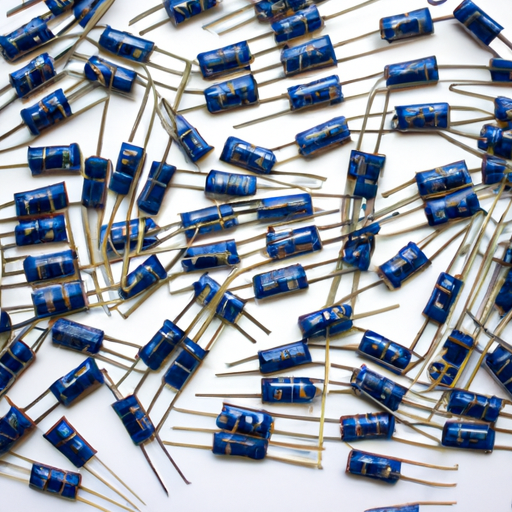What are the Mainstream Models of Automotive Resistors?

I. Introduction
In the intricate world of automotive engineering, resistors play a pivotal role in ensuring the smooth operation of various electrical systems. Automotive resistors are components that limit the flow of electric current, helping to manage voltage levels and protect sensitive electronic devices. Their importance cannot be overstated, as they are integral to the functionality of numerous automotive applications, from engine control units to infotainment systems. This article aims to provide a comprehensive overview of the mainstream models of automotive resistors, exploring their types, specifications, applications, and the latest trends in resistor technology.
II. Types of Automotive Resistors
A. Fixed Resistors
Fixed resistors are the most common type of resistors used in automotive applications. They have a constant resistance value and are designed to perform specific functions within a circuit. These resistors are typically used in applications where the resistance does not need to change, such as in voltage dividers, current limiters, and pull-up or pull-down configurations. Common applications in vehicles include dashboard instrumentation, lighting systems, and various control circuits.
B. Variable Resistors
Variable resistors, as the name suggests, allow for the adjustment of resistance values. They are crucial in applications where fine-tuning is necessary. There are two main types of variable resistors: potentiometers and rheostats.
1. **Potentiometers**: These are three-terminal devices that can adjust voltage levels in a circuit. They are commonly used in automotive applications such as volume controls in audio systems and position sensors for throttle control.
2. **Rheostats**: Rheostats are two-terminal variable resistors used to control current. They are often found in applications like dimmer switches for headlights and fan speed controls.
C. Specialty Resistors
Specialty resistors are designed for specific applications and often have unique characteristics. Some common types include:
1. **Thermistors**: These temperature-sensitive resistors change resistance with temperature variations. They are widely used in automotive temperature sensors, such as those monitoring engine coolant temperature.
2. **Photoresistors**: Also known as light-dependent resistors (LDRs), these resistors change resistance based on light exposure. They are used in automatic headlight systems that adjust based on ambient light conditions.
3. **Strain Gauges**: These resistors measure deformation or strain in materials. In automotive applications, they are used in load cells and pressure sensors to monitor vehicle performance.
III. Key Specifications of Automotive Resistors
Understanding the specifications of automotive resistors is crucial for selecting the right component for a specific application.
A. Resistance Value
The resistance value is a fundamental specification that determines how much current will flow through a resistor. In automotive circuits, common resistance values range from a few ohms to several megaohms, depending on the application. Selecting the correct resistance value is essential for ensuring proper circuit functionality and preventing damage to sensitive components.
B. Power Rating
The power rating indicates the maximum amount of power a resistor can dissipate without overheating. In automotive applications, resistors are subjected to varying power levels, so it is vital to choose resistors with appropriate power ratings. Typical power ratings for automotive resistors range from 0.125 watts to several watts, depending on the application.
C. Tolerance
Tolerance refers to the allowable deviation from the specified resistance value. In automotive applications, maintaining precise resistance values is critical for reliable performance. Common tolerance levels for automotive resistors range from ±1% to ±5%, with tighter tolerances used in more sensitive applications.
D. Temperature Coefficient
The temperature coefficient indicates how much a resistor's resistance changes with temperature. In automotive environments, where temperatures can fluctuate significantly, selecting resistors with low temperature coefficients is essential to ensure stable performance.
IV. Mainstream Models of Automotive Resistors
Several mainstream models of automotive resistors are widely used in the industry, each with its unique characteristics, advantages, and applications.
A. Carbon Composition Resistors
Carbon composition resistors are made from a mixture of carbon and a binding material. They are known for their high energy absorption capabilities and are often used in applications where high pulse power is required. However, they have a relatively high temperature coefficient and lower stability compared to other types. Common applications include older automotive systems and certain high-voltage applications.
B. Metal Film Resistors
Metal film resistors are constructed using a thin film of metal deposited on a ceramic substrate. They offer excellent stability, low noise, and tight tolerance levels, making them suitable for precision applications. Metal film resistors are commonly used in automotive control systems, such as engine management and sensor circuits.
C. Wirewound Resistors
Wirewound resistors are made by winding a metal wire around a ceramic or fiberglass core. They are known for their high power ratings and ability to handle high temperatures. Wirewound resistors are often used in applications requiring high precision and stability, such as in braking systems and power electronics.
D. Thick Film Resistors
Thick film resistors are made by applying a thick layer of resistive material onto a substrate. They are cost-effective and can be produced in various shapes and sizes. Thick film resistors are commonly used in automotive applications such as printed circuit boards (PCBs) and electronic control units (ECUs).
E. Thin Film Resistors
Thin film resistors are similar to thick film resistors but are made with a much thinner layer of resistive material. They offer superior performance in terms of stability, tolerance, and temperature coefficient. Thin film resistors are often used in high-precision automotive applications, such as advanced driver-assistance systems (ADAS) and electronic stability control.
V. Trends and Innovations in Automotive Resistor Technology
As automotive technology continues to evolve, so do the resistors that support these advancements. Here are some notable trends and innovations in automotive resistor technology.
A. Development of Smart Resistors
Smart resistors are equipped with integrated sensors and communication capabilities, allowing them to provide real-time data to automotive systems. These resistors can monitor their own performance and adjust resistance values dynamically, enhancing the overall efficiency and reliability of automotive electronics.
B. Integration with Electronic Control Units (ECUs)
Modern vehicles rely heavily on electronic control units (ECUs) to manage various systems. Resistors play a crucial role in these integrated systems, providing essential feedback and control. The integration of resistors with ECUs allows for more precise control of vehicle functions, improving safety and performance.
C. Advances in Materials and Manufacturing
The automotive industry is witnessing significant advancements in materials and manufacturing processes for resistors. New materials, such as carbon nanotubes and advanced ceramics, are being explored to enhance performance and reliability. Additionally, innovative manufacturing techniques, such as 3D printing, are enabling the production of more complex resistor designs, further expanding their applications in automotive technology.
VI. Conclusion
In summary, automotive resistors are essential components that play a critical role in the functionality and reliability of modern vehicles. Understanding the various types, specifications, and mainstream models of automotive resistors is crucial for industry professionals and enthusiasts alike. As automotive technology continues to evolve, the importance of resistors will only grow, making it imperative to stay informed about the latest trends and innovations in this field. By appreciating the role of automotive resistors, we can better understand the complexities of automotive systems and contribute to the ongoing advancement of automotive technology.
VII. References
1. "Automotive Resistors: Types and Applications." Journal of Automotive Engineering.
2. "Understanding Resistor Specifications." Electronics Weekly.
3. "Advancements in Automotive Electronics." IEEE Transactions on Industrial Electronics.
4. "The Role of Resistors in Modern Automotive Systems." Automotive Technology Review.
What are the Mainstream Models of Automotive Resistors?

I. Introduction
In the intricate world of automotive engineering, resistors play a pivotal role in ensuring the smooth operation of various electrical systems. Automotive resistors are components that limit the flow of electric current, helping to manage voltage levels and protect sensitive electronic devices. Their importance cannot be overstated, as they are integral to the functionality of numerous automotive applications, from engine control units to infotainment systems. This article aims to provide a comprehensive overview of the mainstream models of automotive resistors, exploring their types, specifications, applications, and the latest trends in resistor technology.
II. Types of Automotive Resistors
A. Fixed Resistors
Fixed resistors are the most common type of resistors used in automotive applications. They have a constant resistance value and are designed to perform specific functions within a circuit. These resistors are typically used in applications where the resistance does not need to change, such as in voltage dividers, current limiters, and pull-up or pull-down configurations. Common applications in vehicles include dashboard instrumentation, lighting systems, and various control circuits.
B. Variable Resistors
Variable resistors, as the name suggests, allow for the adjustment of resistance values. They are crucial in applications where fine-tuning is necessary. There are two main types of variable resistors: potentiometers and rheostats.
1. **Potentiometers**: These are three-terminal devices that can adjust voltage levels in a circuit. They are commonly used in automotive applications such as volume controls in audio systems and position sensors for throttle control.
2. **Rheostats**: Rheostats are two-terminal variable resistors used to control current. They are often found in applications like dimmer switches for headlights and fan speed controls.
C. Specialty Resistors
Specialty resistors are designed for specific applications and often have unique characteristics. Some common types include:
1. **Thermistors**: These temperature-sensitive resistors change resistance with temperature variations. They are widely used in automotive temperature sensors, such as those monitoring engine coolant temperature.
2. **Photoresistors**: Also known as light-dependent resistors (LDRs), these resistors change resistance based on light exposure. They are used in automatic headlight systems that adjust based on ambient light conditions.
3. **Strain Gauges**: These resistors measure deformation or strain in materials. In automotive applications, they are used in load cells and pressure sensors to monitor vehicle performance.
III. Key Specifications of Automotive Resistors
Understanding the specifications of automotive resistors is crucial for selecting the right component for a specific application.
A. Resistance Value
The resistance value is a fundamental specification that determines how much current will flow through a resistor. In automotive circuits, common resistance values range from a few ohms to several megaohms, depending on the application. Selecting the correct resistance value is essential for ensuring proper circuit functionality and preventing damage to sensitive components.
B. Power Rating
The power rating indicates the maximum amount of power a resistor can dissipate without overheating. In automotive applications, resistors are subjected to varying power levels, so it is vital to choose resistors with appropriate power ratings. Typical power ratings for automotive resistors range from 0.125 watts to several watts, depending on the application.
C. Tolerance
Tolerance refers to the allowable deviation from the specified resistance value. In automotive applications, maintaining precise resistance values is critical for reliable performance. Common tolerance levels for automotive resistors range from ±1% to ±5%, with tighter tolerances used in more sensitive applications.
D. Temperature Coefficient
The temperature coefficient indicates how much a resistor's resistance changes with temperature. In automotive environments, where temperatures can fluctuate significantly, selecting resistors with low temperature coefficients is essential to ensure stable performance.
IV. Mainstream Models of Automotive Resistors
Several mainstream models of automotive resistors are widely used in the industry, each with its unique characteristics, advantages, and applications.
A. Carbon Composition Resistors
Carbon composition resistors are made from a mixture of carbon and a binding material. They are known for their high energy absorption capabilities and are often used in applications where high pulse power is required. However, they have a relatively high temperature coefficient and lower stability compared to other types. Common applications include older automotive systems and certain high-voltage applications.
B. Metal Film Resistors
Metal film resistors are constructed using a thin film of metal deposited on a ceramic substrate. They offer excellent stability, low noise, and tight tolerance levels, making them suitable for precision applications. Metal film resistors are commonly used in automotive control systems, such as engine management and sensor circuits.
C. Wirewound Resistors
Wirewound resistors are made by winding a metal wire around a ceramic or fiberglass core. They are known for their high power ratings and ability to handle high temperatures. Wirewound resistors are often used in applications requiring high precision and stability, such as in braking systems and power electronics.
D. Thick Film Resistors
Thick film resistors are made by applying a thick layer of resistive material onto a substrate. They are cost-effective and can be produced in various shapes and sizes. Thick film resistors are commonly used in automotive applications such as printed circuit boards (PCBs) and electronic control units (ECUs).
E. Thin Film Resistors
Thin film resistors are similar to thick film resistors but are made with a much thinner layer of resistive material. They offer superior performance in terms of stability, tolerance, and temperature coefficient. Thin film resistors are often used in high-precision automotive applications, such as advanced driver-assistance systems (ADAS) and electronic stability control.
V. Trends and Innovations in Automotive Resistor Technology
As automotive technology continues to evolve, so do the resistors that support these advancements. Here are some notable trends and innovations in automotive resistor technology.
A. Development of Smart Resistors
Smart resistors are equipped with integrated sensors and communication capabilities, allowing them to provide real-time data to automotive systems. These resistors can monitor their own performance and adjust resistance values dynamically, enhancing the overall efficiency and reliability of automotive electronics.
B. Integration with Electronic Control Units (ECUs)
Modern vehicles rely heavily on electronic control units (ECUs) to manage various systems. Resistors play a crucial role in these integrated systems, providing essential feedback and control. The integration of resistors with ECUs allows for more precise control of vehicle functions, improving safety and performance.
C. Advances in Materials and Manufacturing
The automotive industry is witnessing significant advancements in materials and manufacturing processes for resistors. New materials, such as carbon nanotubes and advanced ceramics, are being explored to enhance performance and reliability. Additionally, innovative manufacturing techniques, such as 3D printing, are enabling the production of more complex resistor designs, further expanding their applications in automotive technology.
VI. Conclusion
In summary, automotive resistors are essential components that play a critical role in the functionality and reliability of modern vehicles. Understanding the various types, specifications, and mainstream models of automotive resistors is crucial for industry professionals and enthusiasts alike. As automotive technology continues to evolve, the importance of resistors will only grow, making it imperative to stay informed about the latest trends and innovations in this field. By appreciating the role of automotive resistors, we can better understand the complexities of automotive systems and contribute to the ongoing advancement of automotive technology.
VII. References
1. "Automotive Resistors: Types and Applications." Journal of Automotive Engineering.
2. "Understanding Resistor Specifications." Electronics Weekly.
3. "Advancements in Automotive Electronics." IEEE Transactions on Industrial Electronics.
4. "The Role of Resistors in Modern Automotive Systems." Automotive Technology Review.













